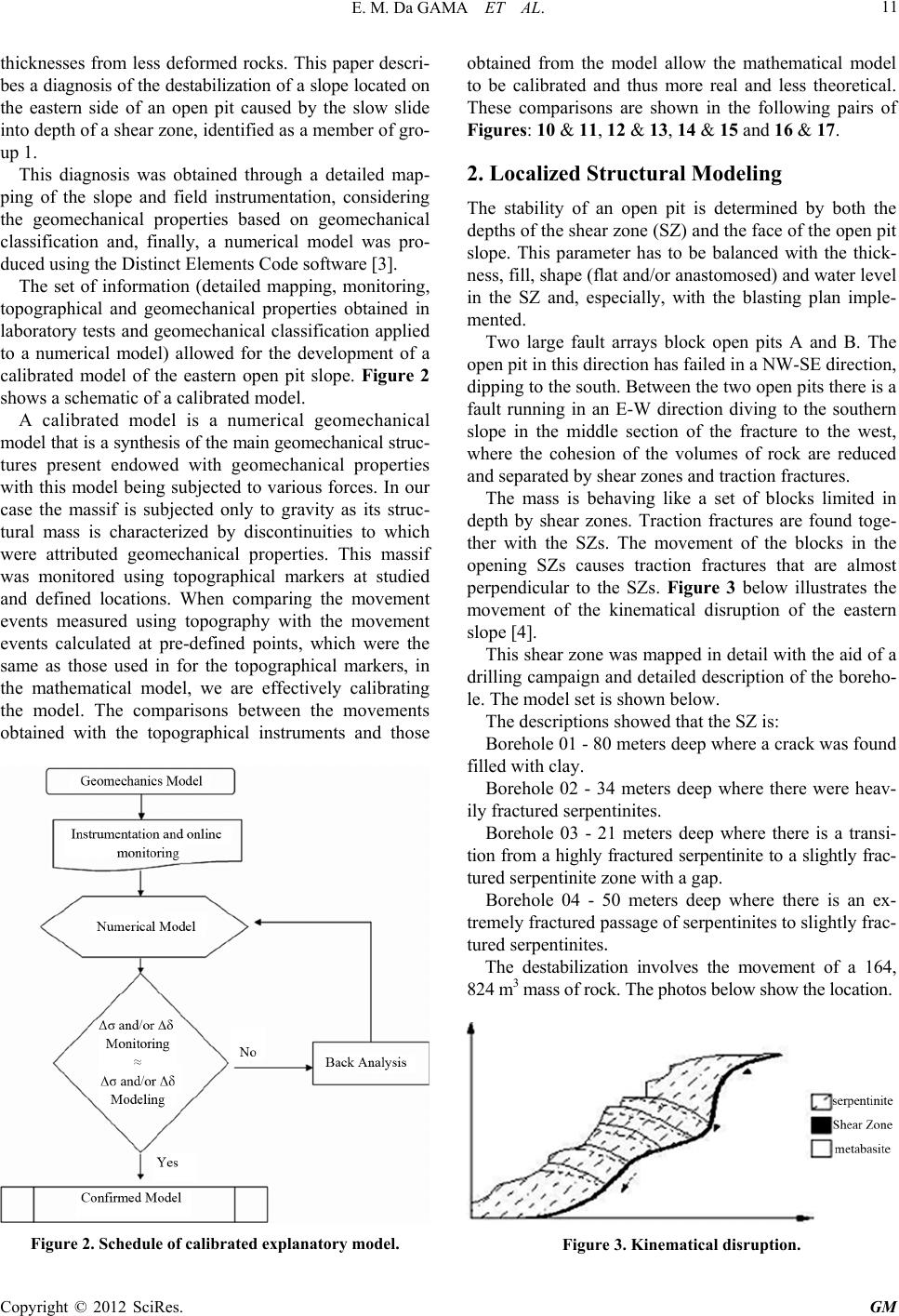
E. M. Da GAMA ET AL. 11
thicknesses from less deformed rocks. This paper descri-
bes a diagnosis of the destabilization of a slope located on
the eastern side of an open pit caused by the slow slide
into depth of a shear zone, identified as a member of gro-
up 1.
This diagnosis was obtained through a detailed map-
ping of the slope and field instrumentation, considering
the geomechanical properties based on geomechanical
classification and, finally, a numerical model was pro-
duced using the Distinct Elements Code software [3].
The set of information (detailed mapping, monitoring,
topographical and geomechanical properties obtained in
laboratory tests and geomechanical classification applied
to a numerical model) allowed for the development of a
calibrated model of the eastern open pit slope. Figure 2
shows a schematic of a calibrated model.
A calibrated model is a numerical geomechanical
model that is a synthesis of the main geomechanical struc-
tures present endowed with geomechanical properties
with this model being subjected to various forces. In our
case the massif is subjected only to gravity as its struc-
tural mass is characterized by discontinuities to which
were attributed geomechanical properties. This massif
was monitored using topographical markers at studied
and defined locations. When comparing the movement
events measured using topography with the movement
events calculated at pre-defined points, which were the
same as those used in for the topographical markers, in
the mathematical model, we are effectively calibrating
the model. The comparisons between the movements
obtained with the topographical instruments and those
Figure 2. Schedule of calibrated explanatory model.
obtained from the model allow the mathematical model
to be calibrated and thus more real and less theoretical.
These comparisons are shown in the following pairs of
Figures: 10 & 11, 12 & 13, 14 & 15 and 16 & 17.
2. Localized Structural Modeling
The stability of an open pit is determined by both the
depths of the shear zone (SZ) and the face of the open pit
slope. This parameter has to be balanced with the thick-
ness, fill, shape (flat and/or anastomosed) and water level
in the SZ and, especially, with the blasting plan imple-
mented.
Two large fault arrays block open pits A and B. The
open pit in this direction has failed in a NW-SE direction,
dipping to the south. Between the two open pits there is a
fault running in an E-W direction diving to the southern
slope in the middle section of the fracture to the west,
where the cohesion of the volumes of rock are reduced
and separated by shear zones and traction fractures.
The mass is behaving like a set of blocks limited in
depth by shear zones. Traction fractures are found toge-
ther with the SZs. The movement of the blocks in the
opening SZs causes traction fractures that are almost
perpendicular to the SZs. Figure 3 below illustrates the
movement of the kinematical disruption of the eastern
slope [4].
This shear zone was mapped in detail with the aid of a
drilling campaign and detailed description of the boreho-
le. The model set is shown below.
The descriptions showed that the SZ is:
Borehole 01 - 80 meters deep where a crack was found
filled with clay.
Borehole 02 - 34 meters deep where there were heav-
ily fractured serpentinites.
Borehole 03 - 21 meters deep where there is a transi-
tion from a highly fractured serpentinite to a slightly frac-
tured serpentinite zone with a gap.
Borehole 04 - 50 meters deep where there is an ex-
tremely fractured passage of serpentinites to slightly frac-
tured serpentinites.
The destabilization involves the movement of a 164,
824 m3 mass of rock. The photos below show the location.
Figure 3. Kinematical disruption.
Copyright © 2012 SciRes. GM